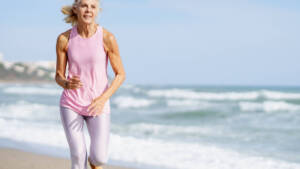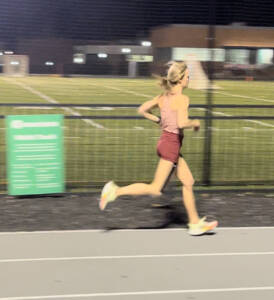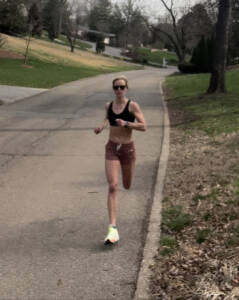You can run or even start running at any age. Master’s runners just need to pay attention to the “little things” like warming up, nutrition, strength training, and sleep to off-set age-related changes such as the decline of tissue elasticity, mobility, and muscle mass. Read on to learn how to run after the age of 40.
If you want to get me fired up, start talking about the limitations of age when it comes to running. I refuse to let age by a boundary or an excuse for not getting faster. Indeed, I vehemently believe that running after 40, running after 50, and beyond is not only possible—it’s possible to get fitter and faster even when “over the hill.”
(I would be remiss to not mention mother runner Sinead Diver who ran a 2:21 marathon at the age of 45 last year!).

I think I am so passionate about this subject of masters running because my dream to run a 2:40-something marathon happened right as I was cresting 40. Unfortunately, I had two major injuries at this time. And many people joked that I got injured because I was now “over the hill.”

I bit my tongue. My injuries came from taking risks, challenging myself, and pushing my body to become stronger and faster than it ever has been. They weren’t from sitting on the couch.
I got hurt because I was running 100 miles a week while also raising young kids and working full-time from home with them.
Get me fired up by also telling me that running is bad for your knees (WRONG) and bad for your body(WRONG again). Haters gonna hate. Maybe because they can’t or they won’t.
Truly, running is the gift that keeps on giving for the body and the mind—regardless of age.
Some mental health benefits for older runners include:
- Better mental acuity
- Better memory
- Less stress and anxiety
- Better sleep
Some physical health benefits for older runners include:
- Lower disability rates
- Better balance (fewer falls)
- Stronger bones
- Fewer diseases
- Stronger cardiovascular system
- Better overall health metrics like weight, heart rate, blood pressure, cholesterol, BMI, and more.
That said, running after 40 and running after 50 and beyond will look different than of those running at the age of 25, for example. My goal with this article is to set master’s runners up for success so they can keep on chasing the dream!
Table of contents
- Can you start running at age 50?
- Is running good for over 40s?
- How much should a 40-year-old run?
- How often should a 50-year-old run?
- How to start running after 50:
- What are the main differences in running between younger and older runners?
- At what age does running become harder?
- What is a good pace for a 50-year-old runner?
- What are tips for running during menopause?
- Here are 8 training tips for runners over 50

Can you start running at age 50?
Yes, you can start running at 50 and beyond. Running is a high-impact sport, but it is one you can ease into. If you are new to running, you may even have an advantage as running for years can limit muscle strength and flexibility, studies show.
If you want to start running after 40 or start running after 50, begin with the following tips.
Related: How to Start Running
Is running good for over 40s?
Running is a great exercise for people of all ages including running after 40 and running after 50 and beyond! I train with lots of runners in their 50s, 60s, and even 70s! Indeed, I am in my 40s and am in best fitness of my life.
Related: How to Become Faster as a Masters Runner
How much should a 40-year-old run?
How much someone should run is determined by several variables including their running background, medical history, injury history, and life stress. Age is a determining factor in how much someone should run but it is influenced by the other factors.
Indeed, an experienced runner in their 50s may run much more than a new runner in their 20s.
The biggest change for an aging runner is to pay attention to the little things such as sleep, recovery, strength, mobility, and nutrition.
How often should a 50-year-old run?
A 50-year-old can run every day as long as that is what their body is accustomed to. In fact, my running coach is age 50 and runs 70 miles per week with fast intensities.
Bear in mind, the CDC recommends that all adults get a minimum of 150 minutes of moderate activity each week. That’s 30 minutes of exercise five days a week. If you run more intensely, the CDC recommends at last 15 minutes 5 days a week of vigorous activity.
How to start running after 50:
- Talking to your doctor to make sure he or she doesn’t have any concerns.
- Go to a running store and get fitted for proper running shoes.
- Buy proper sweat-wicking running gear to keep you comfortable.
- Become comfortable with 30-minute walks before running.
- Download a run/walk plan like mine where you gradually elongate the run intervals.
- Do your running on nonconsecutive days.
- Gradually increase your weekly distance.
- Be sure to warm-up, cool down, and do mobility exercises.
- Cross-train on non-running days.
- Strength training on run days.

What are the main differences in running between younger and older runners?
There are differences between those running at a young age and those running after 40 or running after 50, and so forth. I regularly race and train with those in their 20s. The other weekend, a competitor at the age of 25 beat me. I later learned she was out late the night before partying. That’s something we older runners can’t get away with.
Older runners must pay attention to the details that keep us healthy all around including mobility, strength training, nutrition, sleep, and recovery. That’s because our rate of recovery is diminished. We just don’t “bounce back” as quickly as our younger selves—literally and figuratively.
Specifically, research shows that the main differences between younger and older runners include:
- The decline of tissue elasticity, mobility, and muscle mass
- An increase in the need for recovery time
- A need for a larger focus on speed to enhance the diminishing recruitment of fast-twitch muscle fibers
Related: How I Stopped Being an Injury Prone Runner
At what age does running become harder?

Running may start to feel harder after the age of 60 for experienced runners who have run consistently. If you have taken an extended break from running, then restarting running at an older age may feel more difficult due to decreased mobility and strength.
After age 60, performance declines at a faster rate, research shows. Vigorous training reduces the decline by as much as 50 percent as compared to a sedentary person. The decline between the ages of 35 and 60 are nominal of less than one percent per year.
What is a good pace for a 50-year-old runner?
According to Healthline, the mean pace for a 50-year-old male runner is 11:08 and a 50-year-old female runner is 13:20.
- Age Male Female
- 40–44 10:28 – 12:24
- 45–49 10:43 – 12:41
- 50–54 11:08 – 13:20
- 55–59 12:08 – 14:37
- 60–64 13:05 – 14:47
- 65–99 13:52 – 16:12
Related: My Interview with Pro Runner Neely Gracey
What are tips for running during menopause?
Running during menopause can make running feel harder. But there are things you can do to ease your discomfort, according to Dr. Stacy Sims in ROAR and Neely Gracey in Breakthrough:
- Menopause can raise your body’s core temperature and trigger hot flashes. Taking a dose of the amino acid beta-alanine before running can open blood vessels and improve your body’s thermoregulation.
- Your body will produce less of the sleep-inducing hormone, melatonin. You can counteract this by drinking tart cherry juice before bed. Also, be sure to sleep in cool pajamas.
- Strength train using power moves like plyometrics, hill strides, sprints, and fast reps to wake-up sleepy fast twitch muscles.
- Eat more protein (especially leucine) and complex carbs throughout the day and use energy gels with protein rather than just carbs as your body doesn’t use glucose as efficiently during menopause.
Here are 8 training tips for runners over 50
Related: Running and Menopause Guide
-
Never skip the warm-up and cool-down.

Your warm-up and cool-down become crucial as a master’s runner. Gone are the days where you can roll out of bed and start your run. Set aside 5 to 10 minutes to do some light dynamic stretching, mobility, and foam rolling before your run.
When you’re done with your run, allow your body to recover by jogging easy for one to two miles and then doing some light stretching and foam rolling. Be sure to refuel as well.
Related: 5-Minute Warm-up for Runners
-
Focus on speed.
Running after 40 and running after 50 most often means decreasing the volume of miles you run as the extra mileage can increase your injury risk.
As Brad Hudson and Matt Fitzgerald note in their book, Run Faster, older runners do quality over quantity to minimize “the negative effects of repetitive impact on tissues elasticity in (the) legs.”
What does this mean? Older runners have a need for SPEED. Why? Older runners should run fast for two main reasons:
- You lose speed as you age as fast-twitch muscle fibers atrophy.
- Physiological adaptations happen more slowly as we get old. (So it takes longer to get fitter).
A lot of older runners are afraid to go fast but if you don’t use it, you lose it.
High-intensity workouts include hill repeats, VO2 max intervals, threshold workouts, progression runs, and race pace intervals, for example.
Related: What is a Tempo Workout?
-
Run strides regularly.
Strides (aka striders or stride-outs) are game-changers for runners, but especially master’s runners.
Running strides are a quick and easy way to increase improve overall running economy (how much energy—oxygen–you use to run) by improving areas such as muscle fiber recruitment and running form.
“Master athletes begin to lose maximum power output and maximum aerobic power after age 50. Small and consistent doses of top-end speed training such as strides and hill strides maintain their aerobic power and force production throughout that. I have seen this approach lead to PRs for runners in their 50s plus,” shares running coach Laura Norris.
You run strides by finding a straight, flat, uninterrupted path and run increasingly fast over the course of about 100 meters, cresting close to top speed in the middle. Then slow on the back half to a stop. Fully recover in between to optimize form. Strides are about neuromuscular fitness, not cardiovascular fitness. So don’t rush them.
- Aim to do 4 by 100-meter strides two to three times a week after an easy run or before a speed workout.
Hills are also great strength builders for runners over 40 and runners over 50. For hill strides, find a moderate-grade hill and increase speed over 50 meters so that you crest speed close to the top. Slow to a stop. Jog back down the hill
- Aim to do 4 by 50-meter strides one time a week in place of one of your stride sessions after an easy run.
Related: The Science of Strides (+ How to Run Strides)
-
Incorporate explosive strength.
Strength training is really important for older runners. But the type of strength you do is just as important.
Research shows joint mobility and muscle strength decline with age, especially after age 50. This can impact running performance and increase injury risk
In women especially, hormonal shifts make it harder to build and keep muscle and the percentage of fast twitch muscles fibers decline. But you can work against this, according to Dr. Sims, by adding in more explosive strength training in addition to your basic strength training.

Related: Strength Training Guide for Runners
Explosive strength training includes:
- Hills (like hill strides or short hill sprints of 8-12 seconds)
- Plyometrics
- Fast reps where you go down slow and pop up fast (e.g. in a squat or lunge)
- And short, fast intervals (of 30-120 seconds)
Doing this kind of strength training improves the communication between your brain and muscles in which the brain tells more of your fast twitch muscles to work.
You can aim to do one of these sessions per week. Ensure these intense strength days are sandwiched between easy days. And if you feel fatigued by the time your next harder session comes around, consider adding more recovery or look at your nutrition.
Related: 8 Plyometric Moves for Runners
-
Adopt a regular mobility routine.

Runners need full range of motion of their joints, aka mobility. Unfortunately, this range of motion decreases as we age. This is thrown in my face every day as my gymnast daughter jumps into splits and puts her legs behind her head, and I can barely touch my toes!
You can slow the process of decreased mobility by doing mobility routines that include moves like leg swings, scorpion, cobra, and hip circles. Check out my 5-minute mobility routine here.
Related: 5-minute Mobility Routine for Runners
Doing a mobility routine that incorporates dynamic stretches before a run is never a bad idea.
Foam rolling for 30 seconds on major muscle groups can also help warm-up muscles and improve range of motion before running. Foam rolling for two minutes on major muscle groups with longer stretching after a run may also aid recovery and mobility.
Related: How to Foam Roll
-
Train on a different schedule.
Older runners will take longer to recover between hard workouts. For this reason, runners over 40 and runners over 50 may need to ditch the 7-day calendar and train on a 10 or 11-day “training week” instead.
Using a ten-day or so wheel to train may put your long run mid-week. To avoid this, you can alternate long runs every other week with the shorter long run being a 30 percent or so reduction in mileage, depending on where you are in the training cycle, pace, etc. For example, a marathoner over 60 may have long runs alternating with 10-12 milers on the weekend.
Older runners may also do fewer speed sessions. They may have only one run intensity day a week, rather than two speed days and a workout embedded in the long run. Older runners can supplement this intensity by doing harder cross-training sessions. This will improve their aerobic conditioning without putting them at risk for injury.
This is what sports dietitian and marathoner Megan Robinson does. “I am adding speed through cross-training, like pool running, cycling, and swimming! It’s definitely a shift on how I usually train, but necessary to avoid continued injuries,” she shared.
7. Ramp up nutrition.
Our metabolism and nutrient absorption change as we age, especially with hormonal shifts during menopause and perimenopause. For example, lower estrogen means we use less insulin to process glucose, making it a less optimal fuel.
- Using energy gels that contain some protein and fat can help, suggests Gracey. These energy gels could include Spring or Huma.
- Increase protein intake to counteract muscle loss from age (about 2 to 2.4 grams per kilogram of body weight).
- Also consider taking creatine like Momentous after exercise to improve body composition, mood, and injury Robinson recommends 5 grams for runners over 50 combined with strength training.
- Regularly include complex carbs, high-quality protein (lean meats and yogurt), and healthy omega-3 fat (fish and nuts), foods rich in calcium and vitamin D to keep your tissues and bones healthy and strong.
Related: The Best Energy Gels for Runners
-
Cross-train more.
Runners over 50 may need to run less and run less intensity per week but they can still train their bodies the same amount of volume and intensity by supplementing with cross-training.
Cross-training on off-days or to supplement training on running days can help to improve mobility and improve your endurance. Cross-training activities such as the elliptical, pool running, and cycling are great because they biomechanically mimic running while working your heart and lungs.
Related: The Best Cross-training Exercises for Runners
Running after 40 and running after 50 and beyond is not only possible, but it could also be the best running years of your life—and teach you to take care of yourself holistically!
If you want guidance with your run training, check out my run coaching services. Also, be sure to check out my free training plans:
- Postpartum Training Plan
- After a Break Training Plan
- 5k Training Plans
- 10k Training Plans
- Half Marathon Training Plans
- Marathon Training Plans
- Strength Training Plan
